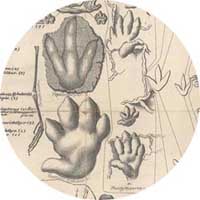
|
|
Fossil footprints
Top: Ornithichnites Giganteus, a bird-like creature, first described and named by Edward Hitchcock in 1836. The footprints were found in the New Red Sandstone, Connecticut.
Bottom and right: Chirotherium footprints, from sandstone, Hildburghausen, first found in 1834. The five-toed nature of the prints, especially as one of the toes looked like a thumb, caused confusion in regards to what the animal actually was as no other remains apart from footprints have been found. It is now considered to be an early ancestor of the crocodile.
Back to main image |
|
|
|
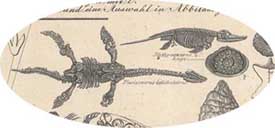 |
|
Plesiosaurus dolichodeiros (Left): Discovered by Thomas Hawkins in the Lias of Street, near Glastonbury. The first specimen of this particular species of animal was found by Mary Anning in 1823.
Ichthyosaurus (Top right): Remains of Ichthyosaurs had been found since the 17th century, however the first complete specimen was discovered by Joseph Anning and his more famous sister Mary Anning between 1811 and 1812.
Back to main image
|
|
|
|
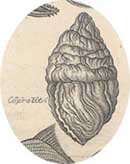
|
|
Coprolite, or fossil faeces
Back to main image |
|
|
|
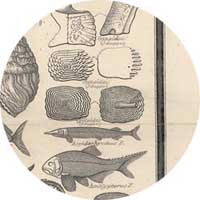
|
|
Scale details and reconstructions of various genera of fossil fish
Although published in William Buckland's 'Bridgewater Treatise', the illustrations were originally commissioned for inclusion in Louis Agassiz’s ‘Recherches sur les Poissons Fossiles’ (1833-1844).
Back to main image |
|
|
|
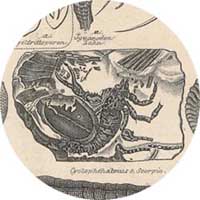
|
|
Fossil scorpion of the genus Cyclophthalmus
Found in the Coal formation of Bohemia, in a quarry of sandy argillaceous Schist. Even the skin, hairs and pores of the tracheae of the animal were preserved.
In the same stone were many carbonized fragments of vegetable remains, including a large fossil nut (on the left hand side).
Back to main image |
|
|
|
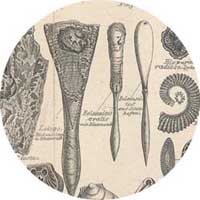 |
|
Illustrations of the genus Belemnosepia (a cuttlefish-like cephalopod).
On the left is Belemnites ovalis, from Lyme Regis, which was in the collection of the famous fossil collector Elizabeth Philpot. The two smaller ones to the right are belemnites from the Jura limestone of Solnhofen, figured by George Graf von Münster, Count Münster, and originally published in Ami Boué’s '‘Mémoires géologiques’ (1832).
Elizabeth Philpot's friend Mary Anning suggested that the fossilised contents from the ink bags of belemnites could be ground up to create a drawing ink. Fossil sepia, as it was known, became extremely popular at the time to depict images of fossils.
Back to main image |
|
|
|
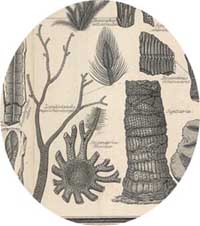
|
|
Remains of plants from the Coal Formation
Left: branch from Lepidodendron Sternbergii found in the roof of a coal mine at Swina, in Bohemia.
Middle: Stigmaria ficoides from Shale in the roof of the Jarrow colliery near Newcastle.
Right: Base of a large trunk of Sigillaria standing in 1803 in the cliff at Bog Hall, near Newbiggin, on the coast of Northumberland. The specimen was reported as being around 5ft high and 2ft 3in in diameter.
Back to main image
|
|
|
|
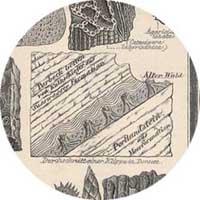
|
|
Section of a cliff east of Lulworth Cove, Dorset
The image shows the inclined position of the petrified stumps of large conifers, and of the bed of black mould and pebbles in which they grew between the Portland and Purbeck stone. Originally published in William Buckland’s and Henry Thomas De la Beche’s paper: “On the Geology of the Neighbourhood of Weymouth and the adjacent Parts of the Coast of Dorset”, ‘Transactions of the Geological Society of London’, Series 2, Volume 4 (1835). Buckland noted that the plants belonged to a species which is now confined to the warmer regions of the earth but were at a former period native to the south coast of England.
Back to main image
|